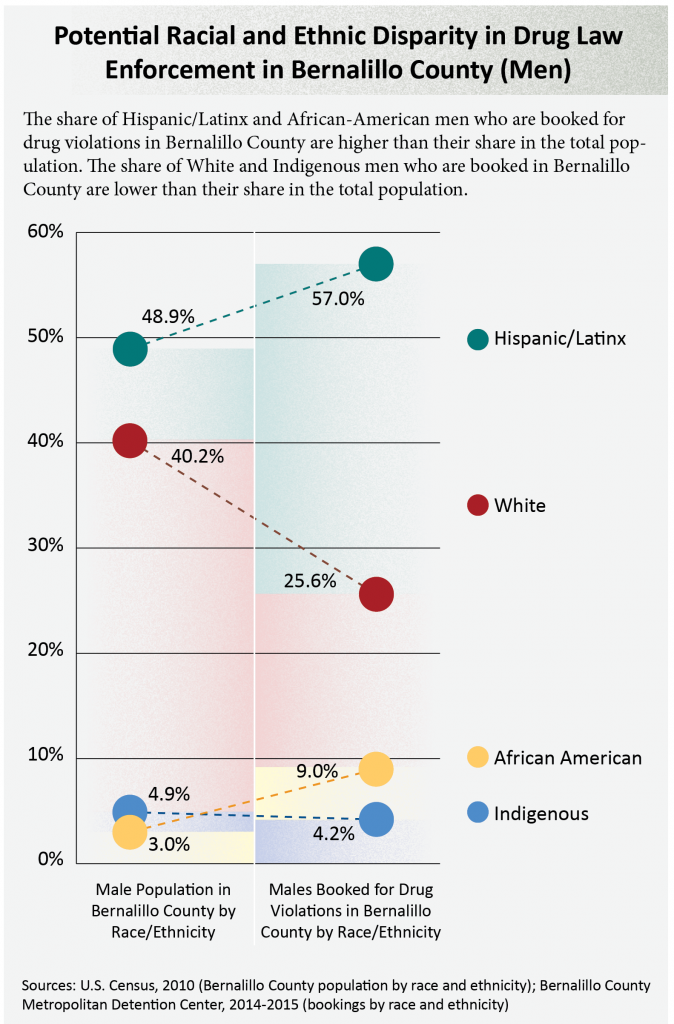
A Summary of Preliminary Findings and Recommendations
Download the policy brief (updated Nov. 2017; 4 pages; pdf)
by ACLU-NM, Drug Policy Alliance, NM Voices for Children, and Young Women United
July 2017
For more than four decades, governments have used harsh criminal punishments as the primary tool to address the possession, use, and sales of illegal substances. Under the guise of the War on Drugs, complex laws and regulations have been created to penalize drug use and the possession of controlled substances at the federal, state, and local levels. These drug laws, along with the interlocking and often contradictory law enforcement systems, have resulted in disparate impacts for people of color.
This brief report summarizes an inquiry by the American Civil Liberties Union of New Mexico, the Drug Policy Alliance, New Mexico Voices for Children, and Young Women United into drug law enforcement in Bernalillo County, which is home of the Metropolitan Detention Center (MDC), the largest detention facility in New Mexico. Specifically, our research analyzed the racial demographics of people arrested and booked on drug law violations (possession and distribution) within the county. Race and ethnicity data collection and reporting procedures were also explored.
In conducting this investigation, we acquired a limited set of arrest data from three law enforcement agencies operating within the county: the Albuquerque Police Department, the Bernalillo County Sheriff’s Office, and the New Mexico State Police. We also gained access to a year’s worth of booking data from MDC.
Preliminary Findings
In line with national trends, our preliminary research found that people of color in Bernalillo County are arrested and booked into jail on drug charges at disproportionately high rates, despite having similar rates of drug use1 and sales2 as white people. This is true for both men and women jailed in MDC. Furthermore, the authors believe that problems with data collection likely mask the true rates of disparity.
Our research also revealed serious problems with the public’s ability to access demographic information on people arrested in Bernalillo County and throughout New Mexico. The state Department of Public Safety instructs New Mexico law enforcement agencies to follow federal procedural guidelines issued by the Federal Bureau of Investigation’s Uniform Crime Reporting (UCR) program. New Mexico’s case tracking system, however, does not meet current federal guidelines for race and ethnicity data collection, and the state does not report race and ethnicity figures related to arrests to the federal government. This lack of transparency has made it difficult to draw precise conclusions about the extent of racial and ethnic bias in drug arrests within the county.
Recommendations
Based on these preliminary findings, we recommend that state and local governments take the following steps:
1. Improve data collection within New Mexico’s criminal justice system overall, with special attention to racial and ethnic identifiers.
• Ensure arrest reporting in New Mexico meets federal guidelines for recording race and ethnicity.3 Support law enforcement agencies and the New Mexico Department of Public Safety in operationalizing the inclusion of these data in their record keeping. Develop data entry instructions and train officers so that race and ethnicity information are collected and reported in a uniform manner.
• Review and revise operating procedures for the collection of race and ethnicity data at booking and other non-arrest data collection points in the criminal justice system.
2. Invest in evidence-based interventions at the local and state levels to reduce racially disparate treatment and overreliance on incarceration, while improving public safety throughout our communities.
Additionally, data collection regarding gender expression and sexual orientation, which are linked to unique forms of disparate treatment, must be explored further. Until we achieve genuine transparency regarding the demographics of people within New Mexico’s criminal justice system, we will be hard-pressed to find better approaches to dealing with problems associated with drug possession, use, and sales within our state.
It is our hope that this research summary will inform policies that support the health and well-being of individuals in Bernalillo County and throughout New Mexico and increase equity in drug law enforcement. For more details about our investigation, please contact Jessica Gelay at the Drug Policy Alliance: jgelay@drugpolicy.org.
Endnotes
1. United States. Health and Human Services. Substance Abuse and Mental Health Services Administration. Results from the 2014 National Survey on Drug Use and Health: Detailed Tables. 2015. Table 1.23 B.
2. Ingraham, Christopher. “White people are more likely to deal drugs, but black people are more likely to get arrested for it.” Washington Post. September 30, 2014.
3. Federal Bureau of Investigation. Uniform Crime Reporting Program. National Incident-Based Reporting System (NIBRS) User Manual. By Law Enforcement Support Section and Crime Statistics Management Unit. 2013. 111-112.



